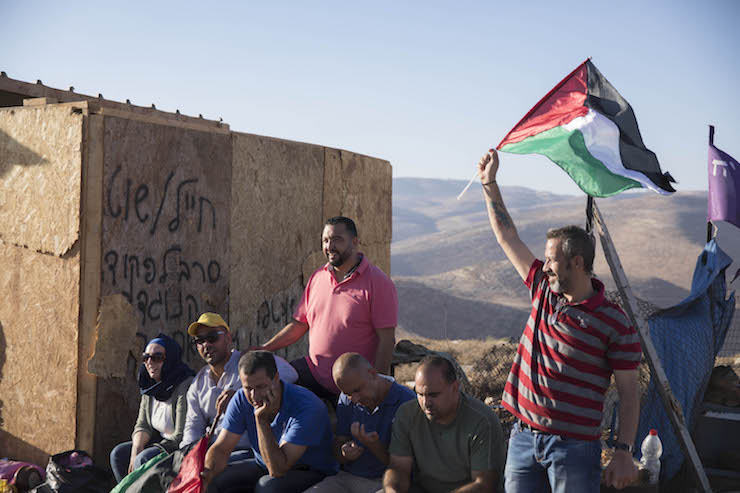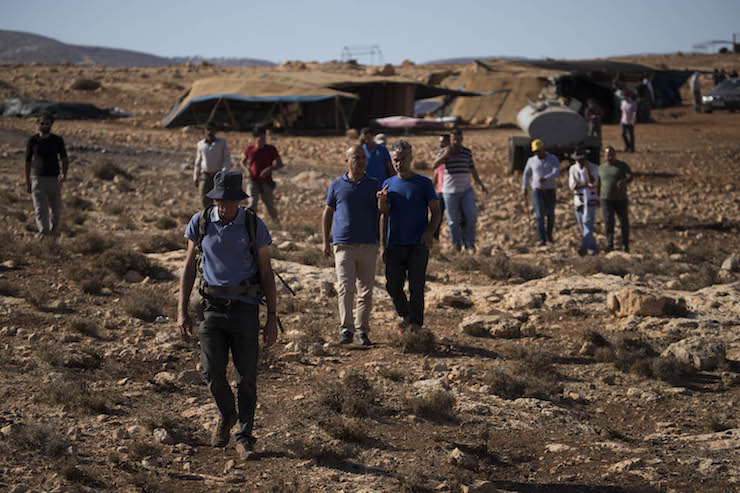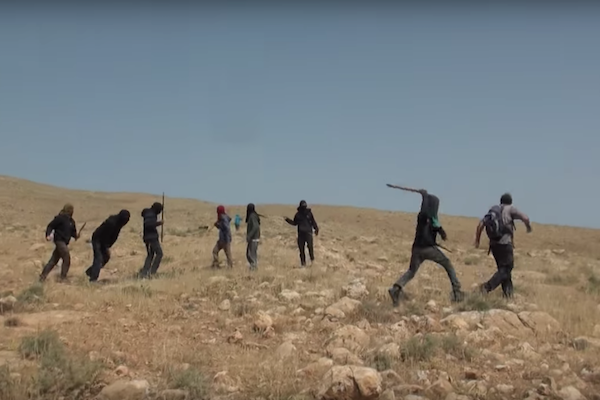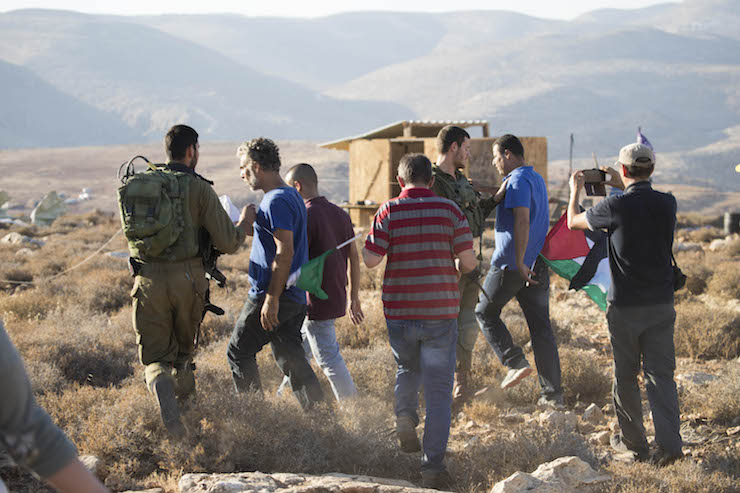Accompanied by Israeli and international activists, the residents of the rural Palestinian community Ein Samia marched to their grazing land, located between the West Bank’s most notoriously violent settlement outposts.
By Oren Ziv

The community of Ein Samia is comprised of 40 families living adjacent to the settlement of Kochav Hashahar, just north of East Jerusalem in the West Bank. The Palestinian residents were expelled from the area in the 70s, when the IDF established a base there as part of the settlement. Since then, the villagers have been living on a nearby hill.
Six years ago, Kochav Hashahar’s outposts, often referred to as the Baladim outposts, began to spread, built by Jewish hilltop youth, whom are known to be among the most violent and extremist settlers in the West Bank. Lately, the attacks on Palestinian residents have been on the rise. Last week, say the villagers, a settler, accompanied by soldiers and a flock of sheep, approached one of the village homes. He tried to attack a Palestinian; the soldiers did the bare minimum, telling the victim of to speak to the police instead.
When he arrived at the police station, he was reportedly arrested and detained for nearly 72 hours. Following the incident, left-wing Israeli activists from the organization Ta’ayush got involved.
Two weeks ago, IDF forces demolished “Maoz Esther,” one of the Baladim outposts, located a kilometer from the fence that surrounds Kochav Hashahar. That very day, the hilltop youth began working on building a new outpost, and by the beginning of last week, a new structure was already in the works.
Last Wednesday, dozens of Israeli, Palestinian, and international activists joined the local activists for a solidarity visit to the grazing land, which belongs to Palestinians, but is located between the two outposts. The Palestinian owners are afraid of approaching without accompaniment. “If we go alone, the settlers immediately head down toward us and throw stones at us,” says H., a 50-year-old resident of Ein Samia.

The walk from Ein Samia to the grazing land is a long one. The area is rich in flora, in the past shepherds from the Jordan Valley would make their way to the area to graze. Today, Kochav Hashahar makes thart impossible. “We have 800 sheep,” tells me another resident as we walk in a long line across a precipice hundreds of meters long. In order to reach the grazing area, one must make a detour of several kilometers, climb down to the valley, and then climb back up for another several hundred meters — all so as not to pass by the outpost. “The grazing area isn’t off limits to us because of the police or the army, but because of the settlers,” says H.
He is certain that the new outpost built last week was meant to create territorial contiguity with Maoz Esther, thus denying them access to the grazing land. “This will create a line that will block us entirely,” he continues. “When we go there with our sheep, the army and the police only look at us because we are doing nothing illegal. But it is likely that someone from the state or the security services (Kochav Hashahar’s security, O.Z.) calculated that if they build a new home, we won’t be to pass between the two outposts.”
“From the army’s perspective, the outpost is illegal, but the security forces (of Kochav Hashahar, O.Z) help them, they protect them. If they see us approaching they immediately call the soldiers,” he adds. In his eyes, the distinction between Kochav Hashahar, which is considered legal according to Israeli law, and its surrounding outposts, is meaningless.
Kochav Hashahar was established in the mid-70s. At first, the army marked the area for the purpose of building a military base, and asked the Palestinian residents to move. “The soldiers told us to ‘move a little.’ Year by year, more people began arriving and it became more difficult,” says H. “If we move another kilometer, they will to where we are living now and take the land. They don’t want us here.”
As we march toward the grazing area, Guy Hircefeld, a Ta’ayush activist who has been accompanying Palestinian communities in the Jordan Valley for years, tells me: “On Wednesday night, we got a call because there were settlers inside the village with the army and the police. The outpost goes up and comes down for years. One of their structures was demolished a day after the attack on the village, and on Friday we came to accompany them. The first time there was quiet, we update the army when we head out because it can be dangerous, and a few days ago they began building a new outpost.”
Some of the activists who came to Ein Samia last week also accompanied shepherds in Al-Auja in the beginning of 2017, where they were violently attacked by the Baladim settlers. Not a single settler was detained or even questioned. “This is the hardcore of the hilltop youth,” says Hircefeld. “It was exceptional that the police warned us, since they are very violent.” He calls the army to update them that we have headed out to the grazing area. “Either the soldiers will come to the area to declare it a closed military zone, or they will protect us. If they forbid us from entering, we’ll have to go to the courts.”

After walking for an hour, we finally arrive at the grazing area between the outposts. In front of us is a hill, where settlers can be said working on building their new outpost. The activists and residents decide to return to the village, marching near the “original” outpost, which was demolished last week and rebuilt the very same day.
As our group approaches the outpost, which includes a dilapidated structure made of wood, with equipment and trash strewn all over, IDF and police jeeps arrive and try to prevent us from approaching the structure. “You cannot get close,” shouts one of the soldiers, who does not show us a closed military zone order. It quickly turns out that the outpost has been abandoned, at least temporarily. From there, the scene only turns more absurd: armed soldiers are diligently protecting an illegal outpost built on Palestinian land, which was demolished and rebuilt — without any settlers to protect. “What are you guarding?” one of the activists asked the soldiers. “I am protecting the orders I was given,” one of them responds.
We were eventually allowed to approach the abandoned outpost. The Palestinian activists take photos with Palestinian flags, even going so far as to place one atop the structure.

After a few minutes, the activists and residents decide to march back toward the village. But the soldiers, who were unhappy with the entire scene, begin chasing after the group as we head down the hill. When a car comes to pick up the tired activists, the soldiers pounce on it, confiscate the key, and search the vehicle. They give up after a few minutes.
Hircefeld promises that there is “more to come,” and that if the shepherds want, the activists will come to support them.
I ask H. if they are worried that the ties with Israeli and international activists will lead to punishment. “I really don’t know,” he answers candidly. “After you go, I don’t know who will come in the nighttime. We don’t sleep at night — with half a liter of gasoline there is no problem burning the entire house,” he says, pointing at his family’s tent, referring to the Dawabshe family, who was burned alive by settlers in the middle of the night, their home only a few kilometers away.
Oren Ziv is a blogger for Local Call, where this article was first published in Hebrew. Read it here.

